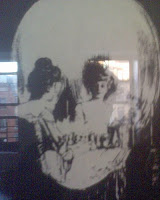
After him, two women walked into the gallery. One was about forty, the other just enough older and similar-looking that I surmised they were mother and daughter. The daughter was tall, lanky, and tan, with red fingernails, teased hair, and a lot of make-up. She wore tan khaki shorts, a short-sleeved white shirt with its collar up. She looked like the kind of woman you would see on a suburban club's tennis courts. Her white-haired mother had a sinking spine and wore dark blue shorts and a white t-shirt with multicolored flowers on it.
"We're from Kechi," the daughter beamed in answer to my asking if they were from Wichita. Kechi (pronounced Kee-CHEE) is a posh suburb of only about 1,000 souls three miles northeast of Wichita that calls itself the "Antique Capitol of Kansas." She spoke brassily as if I were deaf or foreign. Or maybe it was just to be loud enough to be heard over loud prairie winds across Kansas's open range.
"Kechi's a small town; everybody knows everybody," she giggled. "In a small town, there's not a stranger there."
"Not for long any way," the mother added a little menacingly.
The daughter countered, "If you see somebody you don't know, you just make friends with them."
Her mother harrumphed, "I see people more isolated that way here in Wichita."
"The larger the city," the daughter continued, "the more separate, less eye contact. I've never been to New York, but I've heard you don't look people in the eye. If you do, then they feel intimidated." She swiveled toward me. "I find your project fascinating. Most people that would be so interested in a particular artist or style would be an artist themselves, not a writer."
Something about the way she said that made me ask, "Are you an artist?"
"Oh, I was never a very good painter."
"Yes you were," barked her mother.
The daughter lowered her eyes. "I graduated in Fine Art at Wichita State, but I haven't done it for about 15 years now. I'll get back to it one of these years. Maybe when the kids are grown."
"They're pretty big already," the mother challenged.
The daughter considered this for a while. "Maybe this trip to the museum will inspire me to begin again," she mused. "This painting over here is my favorite."  She pointed to a picture of a young woman and skull. It is a common theme, a vanitas or "vanity" painting showing a proud youth and a symbol of death. "I guess I like the whole thought behind it."
She pointed to a picture of a young woman and skull. It is a common theme, a vanitas or "vanity" painting showing a proud youth and a symbol of death. "I guess I like the whole thought behind it."
"I like the Charles Russell stuff," groused the mother. 
"Sometimes," the younger one continued, "I like the symbolism. I can hear the paintings." She said it matter-of-factly, but neither her mother nor I knew how to respond. 
"What's this one sound like?" the mother finally wondered, pointing at George Grosz's  The Pit, which shows various distorted human figures receiving brightly colored tortures.1
The Pit, which shows various distorted human figures receiving brightly colored tortures.1
"I couldn't hear it," the daughter recoiled. "I couldn't look at it for so long. It might be titled 'Hell on Earth.' You might not want to hang it over your living room couch," she said, and then looked at her mom. "But you might live your life differently if you did."
1Edward disliked a Grosz show he saw in 1954, saying "…[Y]ou can't be that mad all the time."
20090323
191 Wichita, KS: Listen
Subscribe to:
Post Comments (Atom)




No comments:
Post a Comment